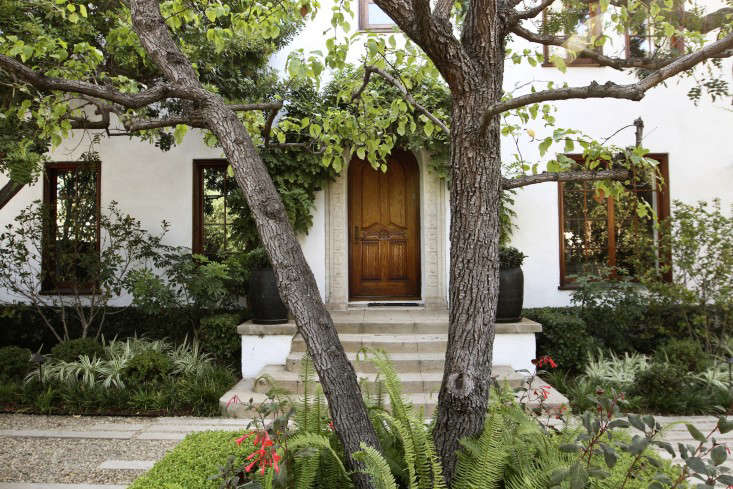With offices in Phoenix, Arizona and Austin, Texas, landscape architect Christine Ten Eyck knows a thing or two about designing in arid landscapes. Lest you think the solution to designing a water-conscious garden is to cover the ground with hardscape and gravel and give up on the plants, we’ve sought out expert advice for fostering lush desert landscapes.
Before pulling out your divining rod and praying for rain, consider implementing her tips for designing a garden in an area where water is scarce:

Above: A gravel gathering space surrounded by trees, low-water grasses, and succulents. Photograph by Terrence Moore.
1. Use low-water native plants and don’t over water. Consider a beautiful low-water succulent garden and plant sedums, agaves, yuccas, and prickly pears.
2. Harvest air conditioner condensate and use to water plants. The beauty of this is that you get the water when you need it: in the summer in hot weather.
3. Use trees as the backbone of the garden. Trees give shade and keep the ground cooler. (Don’t forget to deeply water trees in times of drought.)

Above: Ten Eyck explains, “Brimming water features create an ever changing mirror that reflects the sky and psychologically cools.” Photography by Jeramy Beals.
4. Build a brimming water feature. Stay away from fountains with jets that tend to lose water to spray. Instead, learn from the Moorish gardens in Spain and build a fountain that uses the least amount of water for the most effect.
5. Harvest rainwater in cisterns or by creating swales. Direct the water you collect to trees and gardens.
6. Use drip irrigation and separate shrub valves from tree valves. Drip irrigation helps maintain optimal soil moisture throughout the season and not just in times of drought.

Above: A permeable driveway and retaining wall allow water to soak into the ground and move freely from one level to the next. Photograph by Paul Hester.
7. Use permeable pavers and gravel for gathering spaces and driveways. This allows water to penetrate the soil (don’t use plastic underneath).
8. Use mulches and compost on and in soil. Both help retain water.

Above: Stone check dams and terracing help hold water on a sloping property, providing water to trees and the low-water natives planted beneath them. Photograph by Christine Ten Eyck.
9. If you have a sloping lot, create check dams with stone or salvaged broken concrete. Check dams slow rainwater when it does come and help the water to percolate into the soil.

Above: Garden walls and shade structures shelter the garden from harsh midday sun. Photograph by Christine Ten Eyck.
10. Create microclimates. Use walls and shade structures to shade sections of the garden from the sun.

11. Shower outside with biodegradable soap. Direct the runoff water toward the plants. Photograph by Terrence Moore.
For more from Ten Eyck, see How to Transform An Abandoned Parking Lot Into a Wildlife Habitat, Marfa Edition. Designing a garden? See our complete archive of Ask the Expert posts, including Ask the Expert: 10 Tips for a Zero Waste Garden.












Have a Question or Comment About This Post?
Join the conversation (3)